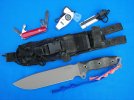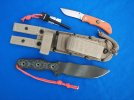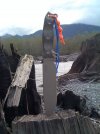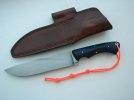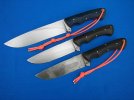This is always such an elusive topic to discuss; the choices of knives are as varied as the personal experiences and skills. Most of the advice given is solid and from experienced users.
I know you mentioned your activities, but you need to refine your requirements. What do you want the knife to do and are you willing to practice those skills necessary to become proficient?
I love large knives and big choppers, but I honestly dont carry them much; theyre just too large and cumbersome for the majority of my activities. I may have one in the pack, but I want my primary blade on my person. The most often quoted advice of the knife you have on you is your survival knife is sage advice. Those that burry their survival knife in the bottom of their pack are not practicing that advice.
Since I strongly encourage having that primary knife on your person, it really makes sense to make it a much more manageable size to carry comfortably. A lot of much more experienced knife users will often recommend a fixed blade knife with a blade between 4-5 inches; and for good reason. I would hazard a guess that over 90% of most knife tasks could be completed with this size of belt knife and with some modified methods could even be used for that last 10%, although they may not be the most efficient, they could do the job if needed.
As to the style of the knife, that again depends a lot on personal preferences, experience and skill. I personally like a straight clip or spear-pointed tip which gives a decent amount of strength. As much as I like Scandi-grinds, I think a good flat or convex grind is better suited for a wider range of cutting needs. Thickness is really not needed and often means more unnecessary weight. For belt knives, I like to keep them under 3/16; thinner knives with a wide profile are quite strong and much better cutters. Steel type has an incredible variance. I like good standard high-carbon steels; 1095, 1065, A2, etc. However, I do have knives with more modern steels that perform well. The trick is to find something that is easier to maintain in the field. Carbon needs a little more attention, but I find it easier to keep sharp in the field.
Dont forget the sheath as part of your system. Its quite important to have something that not only safely retains your knife, but is easy to access and return. How you carry your knife should seamlessly integrate into your clothing and pack wear.
With all that said, the most frequent blade I carry, even when backpacking (which I carried these past couple of weeks on a total of 40+ miles of backpacking), is a Martin Knives BT model. Yes, its a custom and more expensive than most are willing to spend, but a custom knife (of which there are numerous choices here on Bladeforums), can meet your needs but my recommendation would be to first look at some quality off the shelf designs, such as ESSE (4), Fallkniven (F1), or Bark River (already mentioned the Bravo-1). I own all and can highly recommend based on my experience and their performance.
My Martin Knives BT model:
Ironically enough, I ordered this particular model with 1095 steel and they mistakenly sent me an S30V steel variant. It has performed quite well and now has a very good convex edge on it. The sheath is an integral part of my system and includes a small Bird & Trout blade, Fallkniven DC4 sharpening stone and my homemade ferro rods with a pill fob handle holding tinder.
ROCK6




